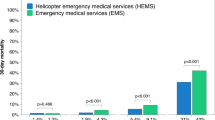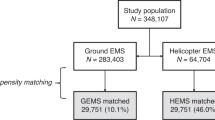Abstract
Background
The purpose of this study was to investigate the relationship between the method of transport after injury and survival among trauma patients admitted to a Level 1 trauma facility in Los Angeles, California.
Methods
The trauma registry of LAC+USC Medical Center was reviewed to identify all injured patients evacuated by emergency medical service (EMS) from the injury scene from 1998 to 2007. The study population was divided into those who were airlifted (HEMS) and those who were transported by ground emergency medical service (GEMS) with transportation time that exceeded 30 minutes (GEMS > 30 minutes).
Results
During the 10-year study period, 1,836 patients were airlifted (helicopters for emergency medical service (HEMS)) and 1,537 patients were ground transported (GEMS > 30 minutes). HEMS patients suffered more frequently a penetrating injury (19% vs. 11%, p < 0.001), presented more often hypotensive to the emergency department (4% vs. 1%, p < 0.001), had more frequently a Glasgow Coma Scale (GCS) ≤ 8 (9% vs. 3%, p < 0.001) and required more often an intubation at the injury scene (1.6% vs. 0.4%, p < 0.001). However, the transportation time and the total prehospital time were significantly shorter for airlifted patients. After multivariable analysis, the difference in mortality between the two transport modalities was not significant (adjusted odds ratio (95% confidence interval, 0.72 (0.22, 2.35); p = 0.596).
Conclusions
In a metropolitan Los Angeles trauma system, EMS helicopter transportation of injured patients does not appear to improve overall adjusted survival after injury. There is however a potential benefit for severely injured subgroups of patients due to the shorter prehospital times.

Similar content being viewed by others
References
Feliciano DV, Mattox KL, Moore EE (eds) (2008) Trauma, 6th edn. McGraw-Hill, pp 160–161
Baxt WG, Moody P, Cleveland HC et al (1985) Hospital-based rotorcraft aeromedical emergency care services and trauma mortality: a multicenter study. Ann Emerg Med 14:859–864
Bledsoe BE, Wesley AK, Eckstein M, Dunn TM, O’Keefe MF (2006) Helicopter scene transport of trauma patients with nonlife-threatening injuries: a meta-analysis. J Trauma 60:1257–1266
McCowan CL, Swanson ER, Thomas F, Handrahan DL (2007) Outcomes of blunt trauma victims transported by HEMS from rural and urban scenes. Prehosp Emerg Care 11:383–388
Brathwaite CE, Rosko M, McDowell R, Gallagher J, Proenca J, Spott MA (1998) A critical analysis of on-scene helicopter transport on survival in a statewide trauma system. J Trauma 45:140–146
Cocanour CS, Fischer RP, Ursic CM (1997) Are scene flights for penetrating trauma justified? J Trauma 43:83–88
Cunningham P, Rutledge R, Baker CC, Clancy TV (1997) A comparison of the association of helicopter and ground ambulance transport with the outcome of injury in trauma patients transported from the scene. J Trauma 43:940–946
Urdaneta LF, Miller BK, Ringenberg BJ, Cram AE, Scott DH (1987) Role of an emergency helicopter transport service in rural trauma. Arch Surg 122:992–996
Schiller WR, Knox R, Zinnecker H et al (1988) Effect of helicopter transport of trauma victims on survival in an urban trauma center. J Trauma 28:1127–1134
Nicholl JP, Brazier JE, Snooks HA (1995) Effects of London helicopter emergency medical service on survival after trauma. BMJ 311:217–222
Thomas SH, Harrison TH, Buras WR, Ahmed W, Cheema F, Wedel SK (2002) Helicopter transport and blunt trauma mortality: a multicenter trial. J Trauma 52:136–145
Nardi G, Massarutti D, Muzzi R et al (1994) Impact of emergency medical helicopter service on mortality for trauma in north-east Italy. A regional prospective audit. Eur J Emerg Med 1:69–77
Bartolacci RA, Munford BJ, Lee A, McDougall PA (1998) Air medical scene response to blunt trauma: effect on early survival. Med J Aust 169(11–12):612–616
Di Bartolomeo S, Sanson G, Nardi G, Michelutto V, Scian F (2005) HEMS vs. ground-BLS care in traumatic cardiac arrest. Prehosp Emerg Care 9:79–84
Hartl R, Gerber LM, Iacono L, Ni Q, Lyons K, Ghajar J (2006) Direct transport within an organized state trauma system reduces mortality in patients with severe traumatic brain injury. J Trauma 60:1250–1256
Meier DR, Samper ER (1989) Evolution of civil aeromedical helicopter aviation. South Med J 82:885–891
Cornwell EE III, Belzberg H, Hennigan K et al (2000) Emergency medical services (EMS) vs non-EMS transport of critically injured patients: a prospective evaluation. Arch Surg 135:315–319
Sampalis JS, Denis R, Lavoie A et al (1999) Trauma care regionalization: a process-outcome evaluation. J Trauma 46:565–581
Sampalis JS, Lavoie A, Williams JI, Mulder DS, Kalina M (1993) Impact of on-site care, prehospital time, and level of in-hospital care on survival in severely injured patients. J Trauma 34:252–261
Demetriades D (1997) Penetrating injuries to the thoracic great vessels. J Card Surg 12(2 Suppl):173–180
Baker FJ II, Baxt WG, Brown GA, Peterson FV Jr, Ross MG (1985) Up, up, and away: aeromedical transport in EMS ··· open forum. Emerg Med Serv 14:26–39
Eckstein M, Jantos T, Kelly N, Cardillo A (2002) Helicopter transport of pediatric trauma patients in an urban emergency medical services system: a critical analysis. J Trauma 53:340–344
Lerner EB, Billittier AJ IV, Sikora J, Moscati RM (1999) Use of a geographic information system to determine appropriate means of trauma patient transport. Acad Emerg Med 6:1127–1133
Svenson JE, O’Connor JE, Lindsay MB (2006) Is air transport faster? A comparison of air versus ground transport times for interfacility transfers in a regional referral system. Air Med J 25:170–172
Baxt WG, Moody P (1983) The impact of a rotorcraft aeromedical emergency care service on trauma mortality. JAMA 249:3047–3051
Diaz MA, Hendey GW, Bivins HG (2005) When is the helicopter faster? A comparison of helicopter and ground ambulance transport times. J Trauma 58:148–153
Mitchell AD, Tallon JM, Sealy B (2007) Air versus ground transport of major trauma patients to a tertiary trauma centre: a province-wide comparison using TRISS analysis. Can J Surg 50:129–133
Mann NC, Pinkney KA, Price DD et al (2002) Injury mortality following the loss of air medical support for rural interhospital transport. Acad Emerg Med 9:694–698
Ringburg AN, Spanjersberg WR, Frankema SP, Steyerberg EW, Patka P, Schipper IB (2007) Helicopter emergency medical services (HEMS): impact on on-scene times. J Trauma 63:258–262
Fischer RP, Flynn TC, Miller PW, Duke JH Jr (1984) Urban helicopter response to the scene of injury. J Trauma 24:946–951
Hotvedt R, Kristiansen IS, Forde OH et al (1996) Which groups of patients benefit from helicopter evacuation? Lancet 347(9012):1362–1366
Baker SP, Grabowski JG, Dodd RS, Shanahan DF, Lamb MW, Li GH (2006) EMS helicopter crashes: what influences fatal outcome? Ann Emerg Med 47:351–356. doi:10.1016/j.annemergmed.2005.11.018
Bledsoe BE, Smith MG (2004) Medical helicopter accidents in the United States: a 10-year review. J Trauma 56:1325–1329
Association of Air Medical Services (1990) Position paper on the appropriate use of emergency air medical services. J Air Med Transp 9:29–33
Air Medical Physician Association (2003) Medical condition list and appropriate use of air medical transport. Air Med J 22:14–19. doi:10.1067/mmj.2003.46
Black JJ, Ward ME, Lockey DJ (2004) Appropriate use of helicopters to transport trauma patients from incident scene to hospital in the United Kingdom: an algorithm. Emerg Med J 21:355–361
Thomson DP, Thomas SH (2003) 2002–2003 Air medical services committee of the national association of EMS physicians. Guidelines for air medical dispatch. Prehosp Emerg Care 7:265–271
Shatney CH, Homan SJ, Sherck JP, Ho CC (2002) The utility of helicopter transport of trauma patients from the injury scene in an urban trauma system. J Trauma 53:817–822. doi:10.1097/01.TA.0000031100.02119.FB
Osler T, Baker SP, Long W (1997) A modification of the injury severity score that both improves accuracy and simplifies scoring. J Trauma 43:922–926
Linn S (1995) The injury severity score–importance and uses. Ann Epidemiol 5:440–446
Amatangelo M, Thomas SH, Harrison T, Wedel SK (1997) Analysis of patients discharged from receiving hospitals within 24 hours of air medical transport. Air Med J 16:44–47
Wong TW, Lau CC (2000) Profile and outcomes of patients transported to an accident and emergency department by helicopter: prospective case series. Hong Kong Med J 6:249–253
Author information
Authors and Affiliations
Corresponding author
Rights and permissions
About this article
Cite this article
Talving, P., Teixeira, P.G.R., Barmparas, G. et al. Helicopter Evacuation of Trauma Victims in Los Angeles: Does it Improve Survival?. World J Surg 33, 2469–2476 (2009). https://doi.org/10.1007/s00268-009-0185-1
Published:
Issue Date:
DOI: https://doi.org/10.1007/s00268-009-0185-1




